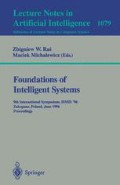Abstract
We present a method for inducing classification rules from imperfect data using an extended version of the rough set model. The salient feature of our method is that it makes use of the statistical information inherent in the information system. Our framework describes the overall induction task in terms of two key subtasks: approximate classification and rule generation.
Preview
Unable to display preview. Download preview PDF.
References
Katzberg, J. and Ziarko, W., “Variable Precision Rough Sets with Asymmetric Bounds,” in Ziarko, W. (ed.), Rough Sets, Fuzzy Sets and Knowledge Discovery, Springer-Verlag, 1994, pp. 167–177.
Michalski, R.S., Carbonell J.G., and Mitchell, T.M. (eds.), Machine Learning: An Artificial Intelligence Approach, vols 1–2. Morgan Kaufmann, San Mateo, California, 1983 and 1986.
Pawlak, Z., Rough Sets: Theoretical Aspects of Reasoning About Data. Kluwer Academic, 1991.
Pawlak Z., and Wong, S.K.M., and Ziarko, W., “Rough Sets: Probabilistic Versus Deterministic Approaches,” International Journal of Man-Machine Studies, 29(1):81–95, 1988.
Quinlan, J. R., “Induction of Decision Trees”, Machine Learning, 1(1):81–106, 1986.
Quinlan, J. R., C4.5 Programs for Machine Learning, Morgan Kaufmann, San Mateo, California, 1992.
Shan, N., Hu, X., Ziarko, W., and Gercone, N., “A Generalized Rough Sets Model,” Proc. of the 3rd Pacific Rim International Conference on Artificial Intelligence, Beijing, China. 1994, pp. 437–443.
Shan, N., Rule Discovery From Data Using Decision Matrices, M.Sc. Thesis, Dept. of Computer Science, University of Regina, 1995.
Wong, S.K.M. and Ziarko, W., A Probabilistic Model of Approximate Classification in Inductive Learning, University of Regina, Technical Report CS-88-01, 1988.
Zhang, J., “Selecting Typical Instances in Instance-Based Learning,” Proc. of the 9th International Workshop on Machine Learning, pp. 474–479, 1992.
Ziarko, W. and Shan, N., “A method for computing all maximally general rules in attribute-value systems,” Computational Intelligence, in press.
Ziarko, W., “Variable Precision Rough Set Model,” Journal of Computer and System Sciences, 46(1):39–59, 1993.
Author information
Authors and Affiliations
Editor information
Rights and permissions
Copyright information
© 1996 Springer-Verlag Berlin Heidelberg
About this paper
Cite this paper
Shan, N., Hamilton, H.J., Cercone, N. (1996). Induction of classification rules from imperfect data. In: Raś, Z.W., Michalewicz, M. (eds) Foundations of Intelligent Systems. ISMIS 1996. Lecture Notes in Computer Science, vol 1079. Springer, Berlin, Heidelberg. https://doi.org/10.1007/3-540-61286-6_137
Download citation
DOI: https://doi.org/10.1007/3-540-61286-6_137
Published:
Publisher Name: Springer, Berlin, Heidelberg
Print ISBN: 978-3-540-61286-5
Online ISBN: 978-3-540-68440-4
eBook Packages: Springer Book Archive

